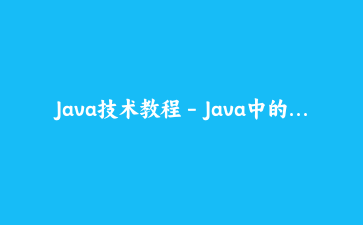Java技术教程 – Java中的NIO(非阻塞I/O)详解与案例
在Java编程中,I/O操作一直是一个重要的部分,但传统的阻塞I/O模型在处理高并发场景时可能会遇到性能瓶颈。Java NIO(New Input/Output,非阻塞I/O)提供了一种更高效的I/O处理方式,它允许一个线程管理多个输入输出通道,极大地提高了I/O处理的效率。
1. NIO的基本概念
NIO主要由三个核心部分组成:Channel(通道)、Buffer(缓冲区)和Selector(选择器)。
- Channel:与传统的Stream不同,NIO中的Channel是可以进行读写操作的双向管道。常见的Channel有SocketChannel、ServerSocketChannel、FileChannel等。
- Buffer:NIO中的所有数据都需要先写入到缓冲区中,然后从缓冲区中获取数据。Buffer提供了对数据的结构化访问。
- Selector:Selector允许一个线程同时管理多个Channel,通过Selector可以监听多个Channel的事件(如连接、读写),从而大大减少了线程的使用。
2. 简单的NIO示例
下面是一个简单的NIO服务端示例,该示例展示了如何使用NIO来处理客户端的连接和数据读写。
2.1 服务端代码
import java.io.IOException;
import java.net.InetSocketAddress;
import java.nio.ByteBuffer;
import java.nio.channels.SelectionKey;
import java.nio.channels.Selector;
import java.nio.channels.ServerSocketChannel;
import java.nio.channels.SocketChannel;
import java.util.Iterator;
import java.util.Set;
public class NIOServer {
public static void main(String[] args) throws IOException {
Selector selector = Selector.open();
ServerSocketChannel serverSocketChannel = ServerSocketChannel.open();
serverSocketChannel.bind(new InetSocketAddress(8080));
serverSocketChannel.configureBlocking(false);
serverSocketChannel.register(selector, SelectionKey.OP_ACCEPT);
while (true) {
selector.select();
Set selectedKeys = selector.selectedKeys();
Iterator iterator = selectedKeys.iterator();
while (iterator.hasNext()) {
SelectionKey key = iterator.next();
if (key.isAcceptable()) {
ServerSocketChannel server = (ServerSocketChannel) key.channel();
SocketChannel client = server.accept();
client.configureBlocking(false);
client.register(selector, SelectionKey.OP_READ);
} else if (key.isReadable()) {
SocketChannel client = (SocketChannel) key.channel();
ByteBuffer buffer = ByteBuffer.allocate(1024);
client.read(buffer);
String received = new String(buffer.array()).trim();
System.out.println("Received: " + received);
buffer.clear();
buffer.put(("Echo: " + received).getBytes());
buffer.flip();
client.write(buffer);
client.close();
}
iterator.remove();
}
}
}
2.2 客户端代码
import java.io.IOException;
import java.net.InetSocketAddress;
import java.nio.ByteBuffer;
import java.nio.channels.SocketChannel;
public class NIOClient {
public static void main(String[] args) throws IOException {
InetSocketAddress address = new InetSocketAddress("localhost", 8080);
SocketChannel socketChannel = SocketChannel.open(address);
socketChannel.configureBlocking(false);
String message = "Hello, NIO!";
ByteBuffer buffer = ByteBuffer.wrap(message.getBytes());
socketChannel.write(buffer);
buffer.clear();
socketChannel.read(buffer);
String received = new String(buffer.array()).trim();
System.out.println("Received: " + received);
socketChannel.close();
}
}
3. 运行示例
先运行服务端代码,然后运行客户端代码。服务端会监听8080端口,当接收到客户端的连接和数据后,会回显收到的数据并关闭连接。
4. 总结
NIO通过非阻塞I/O模型和高效的数据处理方式,提供了比传统阻塞I/O更高的并发性能和更好的资源利用率。通过本教程的学习,你可以掌握NIO的基本概念,并学会编写简单的NIO服务端和客户端程序。













